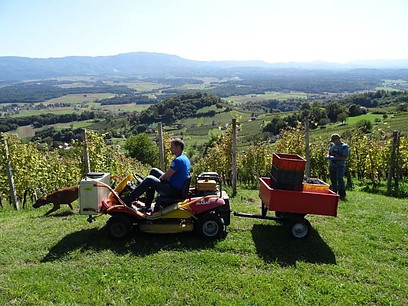Through this article, we give you the opportunity to discover Slovenia’s agriculture. Of course, even through the eyes of the winemaker, what my hobby is.
Agriculture is a minor sector of the Slovenian economy due to the low agricultural potential due to the geographical characteristics of the country.
Farms are traditionally small and self-sufficient. Slovenia is a net importer of agricultural products, mainly from the EU.
It is mainly focused on on-mountain activities (livestock, wine, fruit, and vegetables), although, of course, there is the cultivation of cereals such as wheat or corn. Hops are also grown.
At independence, the main objective of agricultural reform was to encourage the development of farms with a viable economic dimension in the context of sustainable development. Of Slovenia’s total of 2.0 million hectares, more than half is forested, and almost 40% is used for agriculture. There is a great diversity of agricultural production: dairy, suckling, poultry, fruit, vegetables, and cereals … Over the entire agricultural area, more than 60% consists of permanent pastures and about 30% of arable land, half of which is planted mainly in cereals, maize, and wheat.
*** Slovenia’s Agriculture in Figures
– Slovenia’s agriculture accounts for around 3.1% of GDP and 5.5% of employment.
– 8.4% of the workforce – 6% of GNP
– Maize: 62 000 hectares (10% of the agricultural area)
– Wheat: 43 000 hectares (6% of the agricultural area).
*** Strengths and weaknesses of Slovenia’s Agriculture
Since entering the European Union in 2004, Slovenia has entered a stage of development, whether at the industrial or agricultural level. Slovenia must, therefore, analyze its strengths and weaknesses so that its investments are reliable.
*** Some highlights of Slovenia’s Agriculture
– Slovenia has always been in the context of sustainable development, including the project “Slovenia Green,” which aims to promote Slovenia in the most environmentally friendly way.
– Hop cultivation generates a significant export: it rises to 90%.
– There is a great diversity of agricultural production: dairy farms, suckling, poultry and fruits, vegetables, cereals…
*** Some Weak Points of Slovenia’s Agriculture
– Strong import of agricultural products: 45% and 80% in “organic” products. She is not self-sufficient
– Negative trade balance: 30 to 40% of the overall trade deficit
– Small agricultural area
– Family farms do not release a lot of production compared to large agricultural companies.
*** Slovenia, a Wine Country
Of course, Slovenia’s agriculture can go unnoticed, but no one can deny its status as a wine country.
Slovenia is also a wine country. About 800,000 to 900,000 hectoliters of wine are produced per year for a vineyard area of 21,500 hectares. White wine accounts for about 75% of production. Due to the high consumption of wine in Slovenia, 30% of the production has only the status of table wine (namizno vino). Still, most wine production can apply for the classification of quality wine (vrhunsko ). A growing number of producers have chosen this route, and their wines are at the level of those of Western Europe.
